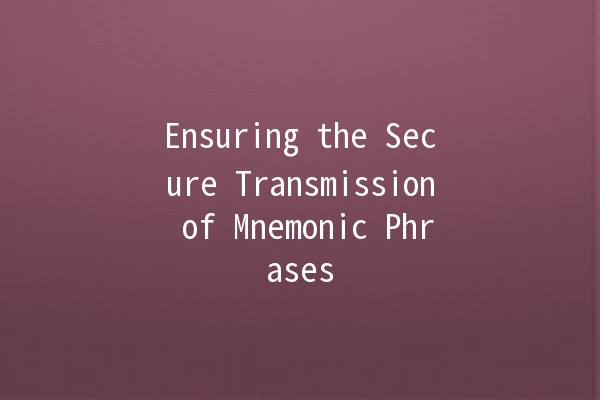
In the realm of digital security, one of the most crucial aspects is the safeguarding of mnemonic phrases. A mnemonic phrase, often referred to as a recovery phrase or seed phrase, is a set of words used to recover wallets or accounts, particularly in the cryptocurrency space. Given the increasing prevalence of cyber threats, ensuring that these phrases are transmitted securely has become paramount. Here, we will explore effective techniques to secure the transmission of mnemonic phrases while integrating SEO best practices to enhance visibility on the web.
Understanding the Importance of Mnemonic Phrases
Mnemonic phrases act as an access key to sensitive digital assets. Losing or exposing these can lead to irretrievable losses. For instance, someone could gain unauthorized access to a cryptocurrency wallet and drain it of its funds. Therefore, safeguarding these phrases during transmission is critical for individuals and businesses alike.
The Risk of Insecure Transmission
When mnemonic phrases are transmitted insecurely, they become susceptible to various attacks, including:
Phishing Attacks: Cybercriminals trick users into entering mnemonic phrases on fake websites.
ManintheMiddle Attacks: Attackers intercept communications between two parties to gain access to sensitive information.

Malware: Malicious software can capture keystrokes or data sent over insecure connections.
Understanding these risks underscores why implementing secure transmission methods is vital.
5 Techniques to Increase the Security of Transmitting Mnemonic Phrases
Explanation: toend encryption ensures that data is encrypted on the sender's device and only decrypted on the receiver's device, preventing unauthorized access during transmission.
Implementation Example: Messaging applications like Signal and WhatsApp use endtoend encryption to enhance the security of the messages exchanged. By adopting similar encryption standards for transmitting mnemonic phrases, users can substantially reduce the risk of interception.
Why It Matters: This method ensures that even if data is intercepted, it remains inaccessible without the decryption key.
Explanation: Secure channels, such as HTTPS or VPNs, provide an additional layer of security when transmitting sensitive information.
Implementation Example: When sharing mnemonic phrases via a messaging platform, ensure it operates over HTTPS or use a VPenabled connection. This could apply to websites that facilitate the sharing of sensitive information.
Why It Matters: Secure channels help protect data in transit from eavesdroppers and reduce the likelihood of unauthorized access.
Explanation: Twofactor authentication requires a second form of verification beyond just the mnemonic phrase, adding another layer of security.
Implementation Example: If a service requires a mnemonic phrase, it could also prompt a notification to a user’s mobile device. Access would only be granted if both the mnemonic and the mobile confirmation are provided.
Why It Matters: Even if an attacker obtains the mnemonic phrase, they would not be able to access funds or sensitive accounts without the second factor.
Explanation: Educating users about the importance of security practices is essential for minimizing risks.
Implementation Example: Regularly host webinars or create content that advises users on identifying phishing attempts, safely handling mnemonic phrases, and recognizing suspicious activity.
Why It Matters: Wellinformed users are less likely to fall victim to scams or make mistakes that could compromise their mnemonic phrases and digital wallets.
Explanation: Implementing integrity checks ensures that the message has not been tampered with during the transmission process.
Implementation Example: Incorporate hash functions to create a unique fingerprint of the mnemonic phrase before transmission. Upon receipt, the recipient can verify the fingerprint against the original.
Why It Matters: This additional step confirms that the transmitted phrase matches what was originally sent, enhancing trust in the communication process.
Best Practices for Storing Mnemonic Phrases
While securing the transmission of mnemonic phrases is essential, it is equally crucial to store them securely. Here are a few best practices:
Use Hardware Wallets
Hardware wallets are physical devices that securely store mnemonic phrases offline. Using these devices minimizes the risk of being hacked, as they are not connected to the internet when not in use.
Avoid Cloud Storage
Storing mnemonic phrases in cloud services can expose them to vulnerabilities. Instead, consider offline options, such as writing them down and keeping them in a safe place.
Regularly Update Security Practices
Continuously review and update security protocols to counter new threats. Keep abreast of the latest cybersecurity trends to ensure best practices are enforced.
FAQs about Securing Mnemonic Phrase Transmission
A mnemonic phrase is a sequence of words used to recover or access digital wallets. It is crucial because it serves as the key to accessing digital assets, such as cryptocurrencies. If compromised, individuals can lose their assets permanently.
Transmitting mnemonic phrases without security can lead to interception by cybercriminals through phishing attacks, maninthemiddle attacks, or malware. This can result in unauthorized access to sensitive information and significant financial losses.
toend encryption encrypts data on the sender's device and only decrypts it on the recipient's device. This ensures that only authorized users can read the message, preventing unauthorized access during transmission.
Twofactor authentication (2FA) requires users to verify their identity using two forms of verification. This means that even if a hacker gains access to the mnemonic phrase, they would still need the second form of verification to access the account or wallet, greatly increasing security.
User education is critical because informed users are better equipped to recognize threats and avoid risky behaviors. By educating users on secure practices, such as identifying phishing scams and securely handling mnemonic phrases, organizations can significantly reduce the risk of attacks.
If you suspect that your mnemonic phrase has been compromised, immediately transfer your assets to a new wallet with a fresh mnemonic phrase. Make sure to utilize secure channels and practices when creating the new wallet to prevent future incidents.
By understanding and implementing these techniques, individuals can better safeguard their mnemonic phrases during transmission. The digital landscape is rife with potential threats, but with the right strategies, securing sensitive information is more achievable than ever.

